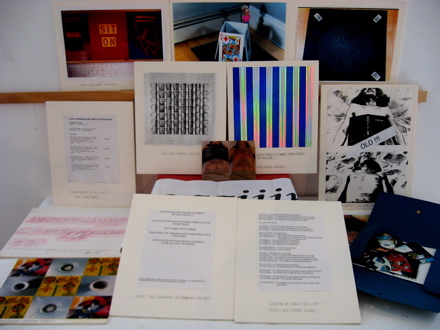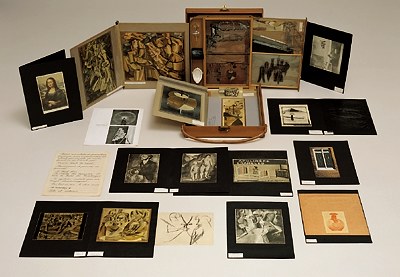
In 1994 along with putting up a web site called, Faux Conceptual Art, I also created a series of drawings/sketches/proposal boards for an exhibition of “fake” or remade conceptual art pieces. My premise was that the media coverage of information art had created information that could be montaged, copied or re-used. I made several appointments with gallery dealers to “pitch” my idea for a Faux Conceptual Art exhibition. Using the proposal boards I performed the work in a presentation form. Needless to say the gallerists did not understand what was happening. At that point neither did I. The creative process is not a straight line. Often while investigating a new form or approach, an artist may create a series of drawings in an attempt to achieve a clarity of vision and form. Perhaps an author will write a series of short stories before attempting a novel, or a musician will create short compositions before fashioning a larger work.
If one works with information art, than this must also be the case. The dynamic within this art world, the capitalist mode of production and consumption and the demand for individual objects that function as commodities in the art market seem to be at odds with the creative work processes. The demand for a signature style and a recognizable discreet art object that is self-contained is all the more precious in world of mass production. The advertising and marketing segments of hyper-capitalism have actually detached the sign or signature style from the manufactured object. Indeed, the logo, has more power than even the signature style or master from which copies are struck. This all becomes a language game. In other words the logo or sign, gives power to any manufactured object. This sign or logo has been heavily advertised and promoted within the information sphere so that it achieves worldwide recognition. The art world also has a marketing and advertising segment. When Conceptual Art was first presented, it was in the context of a media sphere. It fit quite nicely within the information of an art magazine. Conceptual Art in particular had several strategies that were intended to combat market frenzy or to enlarge the definition of the art object beyond that of traditional painting and sculpture, among them the idea that an artwork can be a set of instructions that the viewer or anyone can follow thereby achieving the intended aesthetic experience. Another strategy to avoid or short circuit the marketing mechanisms was performance art and in particular “Body Art.” These performance works extended the teleology of modernist questioning of the structure of art and used the artists’ body as both the raw material to create an artwork and the location for the work. Often this type of Body Art involved a performance in front of a camera, either a still camera or a video/film camera. Indeed most Conceptual Art had a media component that used a camera to “document” the event in some way. This is the point where media and mass media intersect art and transform it into a sign within the media sphere. The interesting point is that the documentation of Conceptual Art is open to interpretation. A photograph or a video or a set of instructions is not the actual work. There is a layer of media in between the artwork and the person viewing it. Often the original doesn’t exist because it was a performance. This allows for a series of challenges and inquiries into the meaning of the work and the veracity of the documentation. Indeed, the look and feel of early Conceptual Art, the use of cheap photos, the text, the residue of a performance, the youthful physiques and long hair of the body artists become stylized signifiers, pointing to a type of unintentional nostalgic meaning.
Faux Conceptual Art has three components. They are 1. a web site, 2. a boxed set of development proposal boards and 3. physical objects. The project investigates information, concept and ideas that are presented in various ways and at various times. The project is ongoing. It is an extended performance but in this case I am performing the media.
Perhaps I meant to say I am activating the media. There is a fourth component I have recently added and that is the essays and notes I’m presenting on a blog. This creates a rich and overlapping series of art works that have the same meaning and intent yet are viewed in different ways depending on the media. The information substructure of Faux Conceptual Art, is that each manifestation engages a different media context. For example the web site is “new media” information. It’s also a direct challenge to the idea of a fixed meaning for an artwork, especially a Conceptual Art work. The web site takes the proposals for the unmade works in the series, plus the documentation of some that are executed and adds a manifesto/proposal/information site context. This might be thought of as a “de/re-contextualized” strategy. To further escalate the idea of the client/server open-ended aspect of the internet, there are instructions for a do-it-yourself artwork called Video-Affirmations. These are fake, new age affirmations that can be printed out by the viewer and pasted on a wall. There are documentation examples of just such an installation as a guideline. The affirmations are also presented in four small videos on the website. These feature people faces painted like modernist paintings and has them saying their favorite affirmation. As part of the cyclical nature of information, the still photos of the videos and the printouts of the affirmations are preserved in a document folder that functions as an archive or documentation of the work. It is also a presentation tool and is incorporated into the proposal boards. In this instance it is a work that has been made and is also a proposal for work to be made. It sits oddly in a balanced state of potentiality. It has existed in the past and may exist again in the future but in the present it exists only as a marker or a pointer to some other event. This presents the dilemma of media. The documentation is also a work of art even as it is used as a proposal for another work to be executed. In terms of an artwork this really fools with the market and the reification of an artwork. How can one have an artwork that both simultaneously exists and doesn’t exist? Or perhaps the question should be how can an artwork extend beyond its’ temporal and physical limits? If that is the case with these works than it appears that the documentation and/or the proposal to create an artwork based on the documentation is only a certain percentage of the full artwork. In terms of a marketable object it is somehow incomplete. It does however relate to the actual creative process that is a continuum for any artist.
I would have no trouble selling the complete boxed set of proposal boards as one piece. To site a forebear, my work directly relates to Marcel Duchamp’s work called boite-en-valise. I see Duchamp’s piece as a sort of archive of his thoughts. The Boite-en-valise is also simply a marker that points to a mnemonic for the original work just as it also point to the art historical discourse, context and narrative to give the piece its’ meaning and value. For my piece Show-in-a-box, I see it as a series of ideas mapped out fourteen years ago. I am consciously re-opening this artwork and beginning to make new works and new proposals for Conceptual Art re-makes.
 boite-en-valise
boite-en-valise